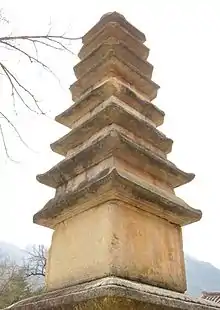| Tabo Pagoda of Pohyonsa Buddhist temple | |
 | |
| Korean name | |
|---|---|
| Chosŏn'gŭl | 보현사사각구층탑 |
| Hancha | 普賢寺四角九層塔 |
| Revised Romanization | Bohyeonsa-sagakgucheungtap |
| McCune–Reischauer | Pohyŏnsa-sagakkuch'ŭngt'ap |
| Alternative name | |
| Chosŏn'gŭl | 다보탑 |
| Hancha | 多寶塔 |
| Revised Romanization | Dabotap |
| McCune–Reischauer | Tabot'ap |
The Tabo Pagoda of the Pohyonsa Buddhist temple (Korean: 보현사사각구층탑) is located at Pohyonsa on Mt. Myohyang, Hyangam-ri, Hyangsan County, North Pyongan Province, North Korea. It is a National Treasure in the country.[1] A one-third model of the Pagoda is on display at the Korean Central History Museum in Pyongyang.[2]
Details
Also known as the "Pagoda of many treasures", this structure is a two-storey pagoda. The first storey consists of a platform with four stone staircases leading up to the elevated portion. Here, four pillars create a sheltered area that is thought to once have held a Buddhist statue. The second central stage is made of a simple cornice with rounded, beam-like blocks of granite.[3]
The pagoda is the feminine counterpart to the masculine Sokka Pagoda of the Pulguska Temple; it inspired the design of the French Embassy in Seoul by Korean architect Kim Chung-up.[4]
References
- ↑ "The 13-storeyed Octagonal Pagoda of the Pohyon Temple". naenara.com.kp. Korea Computer Center in DPRKorea & Foreign Languages Publishing House. 2014 [2003]. Retrieved November 9, 2014.
- ↑ The Korean Central History Museum. Pyongyang: Korea Pictorial. 2006. Retrieved May 26, 2015.
- ↑ "Pul-guk-sa Temple". University of Idaho. Retrieved June 4, 2014.
- ↑ Ui Ahn, Byung (Autumn 1989). "Remembrances: Kim Chung-up". Koreana. Korea Foundation: 18–21. Archived from the original on 7 December 2014. Retrieved 7 November 2014.